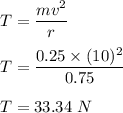
Physics, 28.10.2020 16:40 mlrood2013oy11gv
9. A 0.25-kg mass is attached to a string and swung in a vertical circle whose radius is 0.75 m. At the bottom of the circle, the mass is observed to have a speed of 10 m/s. What is the magnitude of the tension in the string at that point

Answers: 2


Another question on Physics


Physics, 22.06.2019 01:10
Suppose that two tanks, 1 and 2, each with a large opening at the top, contain different liquids. a small hole is made in the side of each tank at the same depth 1.57 m below the liquid surface, but the hole in tank 2 has 2.49 times the cross-sectional area of the hole in tank 1. (a) what is the ratio ρ1/ρ2 of the densities of the liquids if the mass flow rate is the same for the two holes? (b) what is the ratio rv1/rv2 of the volume flow rates from the two tanks? (c) at one instant, the liquid in tank 1 is 14.9 cm above the hole. if the tanks are to have equal volume flow rates, what height above the hole must the liquid in tank 2 be just then?
Answers: 3

Physics, 22.06.2019 03:30
As part of an industrial process, air as an ideal gas at 10 bar, 400k expands at steady state through a valve to a pressure of 4 bar. the mass flow rate of air is 0.5 kg/s. the air then passes through a heat exchanger where it is cooled to a temperature of 295k with negligible change in pressure. the valve can be modeled as a throttling process, and kinetic and potential energy effects can be neglected. (a) for a control volume enclosing the valve and heat exchanger and enough of the local surroundings that the heat transfer occurs at the ambient temperature of 295 k, determine the rate of entropy production, in kw/k. (b) if the expansion valve were replaced by an adiabatic turbine operating isentropically, what would be the entropy production? compare the results of parts (a) and (b) and discuss.
Answers: 3

Physics, 22.06.2019 14:20
4r-134a enters the condenser of a residential heat pump at 800 kpa and 50°c at a rate of 0.022 kg/s and leaves at 750 kpa subcooled by 3°c. the refrigerant enters the compressor at 200 kpa superheated by 4°c determine (a) the isentropic efficiency of the compressor, (b) the rate of heat supplied to the heated room, and (c) the cop of the heat pump. also, determine (d) the cop and rate of heat supplied to the heated room if this heat pump operated on the ideal vapor-compression cycle between the pressure limits of 200 and 800 kpa. (0.757, 4.37 kw, 5.12, 6.18, 3.91 kw)
Answers: 3
You know the right answer?
9. A 0.25-kg mass is attached to a string and swung in a vertical circle whose radius is 0.75 m. At...
Questions

Engineering, 17.03.2021 23:40





Mathematics, 17.03.2021 23:40

Mathematics, 17.03.2021 23:40



Mathematics, 17.03.2021 23:40


English, 17.03.2021 23:40


Computers and Technology, 17.03.2021 23:40

Mathematics, 17.03.2021 23:40



Arts, 17.03.2021 23:40

Arts, 17.03.2021 23:40





